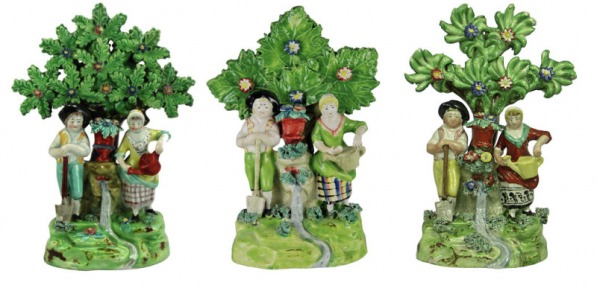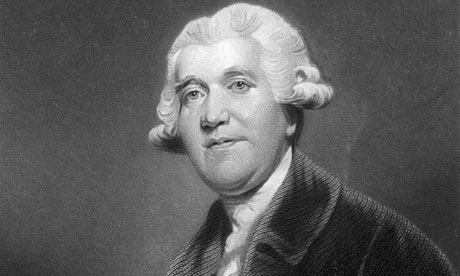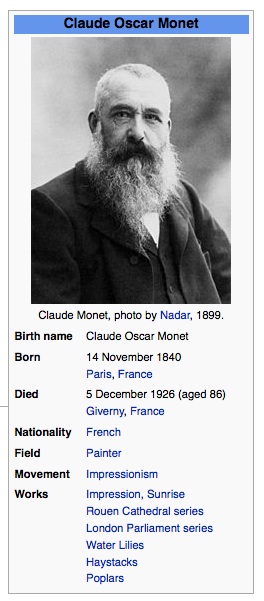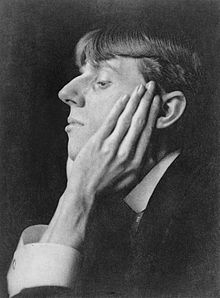We postulate that the man behind the Walton mark found on so many early nineteenth-century enamel-painted figures was John Walton and that he was active in Burslem from about 1806 until about 1835. Burslem parish records indicate that a John Walton was baptized on February 20, 1780, and that his first child was born in 1802.1 By 1802, John Walton was probably employed in the Potteries. Reginald Haggar concurs with William Chaffers in concluding that John Walton was a manufacturer by about 1806.2
 John Walton’s name first appears in trade directories in 1818, when “Earthenware Manufacturers” are listed as a distinct group. By all accounts, by 1818 Walton was a well-established manufacturer with diverse enterprises. Parsons & Bradshaw’s March 1818 directory lists John Walton both as a “Colour Maker” on Pleasant Street, Burslem, and as an “Earthenware &c. Manufacturer” at Haderage, Burslem.3 That same year, Walton probably abandoned color-making to focus on potting, for Pigot’s August 1818 directory records him only as an earthenware manufacturer at a new location: Navigation Road, Burslem.4
John Walton’s name first appears in trade directories in 1818, when “Earthenware Manufacturers” are listed as a distinct group. By all accounts, by 1818 Walton was a well-established manufacturer with diverse enterprises. Parsons & Bradshaw’s March 1818 directory lists John Walton both as a “Colour Maker” on Pleasant Street, Burslem, and as an “Earthenware &c. Manufacturer” at Haderage, Burslem.3 That same year, Walton probably abandoned color-making to focus on potting, for Pigot’s August 1818 directory records him only as an earthenware manufacturer at a new location: Navigation Road, Burslem.4
Walton’s figures are his legacy, but he made other wares too. Allbutt’s 1822 directory records that John Walton made both figures and Egyptian black wares,5 and Pigot’s directories for 1828 and 1830 list John Walton as a general earthenware manufacturer.6 White’s directory of 1834 confusingly notes John Walton under both “Egyptian black mfrs. only,” (i.e. basalt wares) and “Toy Manufacturers,”7 but Pigot’s 1835 directory clarifies matters by listing John Walton at two Burslem premises: at Navigation Road as a general “Earthenware Manufacturer” and at Waterloo Road as a “Toy and Ornamental China Manufacturer.”8 Apparently by 1834 the “toy” or figure business was successful enough to warrant expanding to a dedicated facility at the Waterloo Road location. Walton probably stopped working shortly thereafter, because his name does not appear in subsequent directories. In June 1839, his Navigation Road manufactory—a two-oven facility—was auctioned by its then owner, a bankrupt figure potter of around sixty years of age: Walton’s son-in-law, George Hood.9 John Walton may have died by this date. We know Walton’s wife died in August 1830,10 but the date of his death remains unknown.
But we cannot be certain that the John Walton listed in trade directories was the Walton who manufactured the figures we collect. A Walton mark does not occur on any basalt wares, despite John Walton’s recorded production of that stoneware body. To complicate matters, the names of other Waltons abound in the directories. James Walton, Joseph Walton, and Stephen Walton, all of the Potteries hamlet of Shelton, are described in early-nineteenth-century manorial records as potters11—as is John Walton of Burslem.12 Trade directories of 1830, 1834, 1835, and 1841 record the existence of Joshua Walton of Shelton, a specialist toy manufacturer,13 yet there is no evidence that Joshua Walton marked any of his figures. However, since the criteria for inclusion in trade directories are not known, and since errors and omissions were almost certainly made, we cannot dismiss the slim possibility that Joshua Walton—or some other Walton—was potting from an earlier date and was connected in some way with marked Walton figures.
Credit:
http://www.mystaffordshirefigures.com/





















